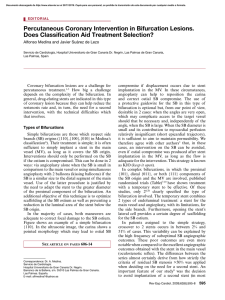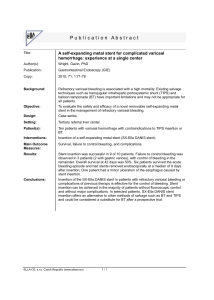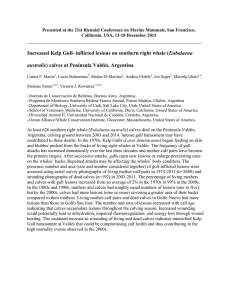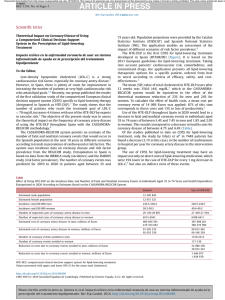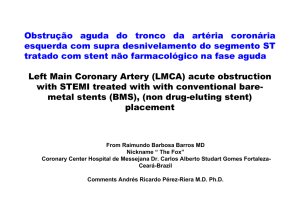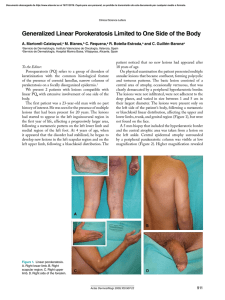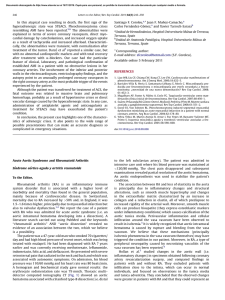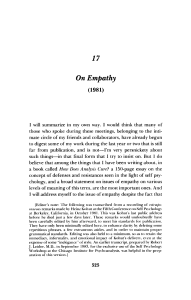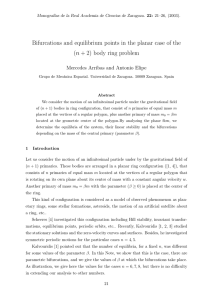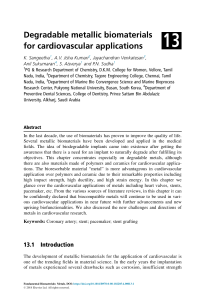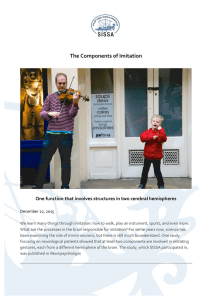Percutaneous treatment of coronary bifurcations To the Director
Anuncio
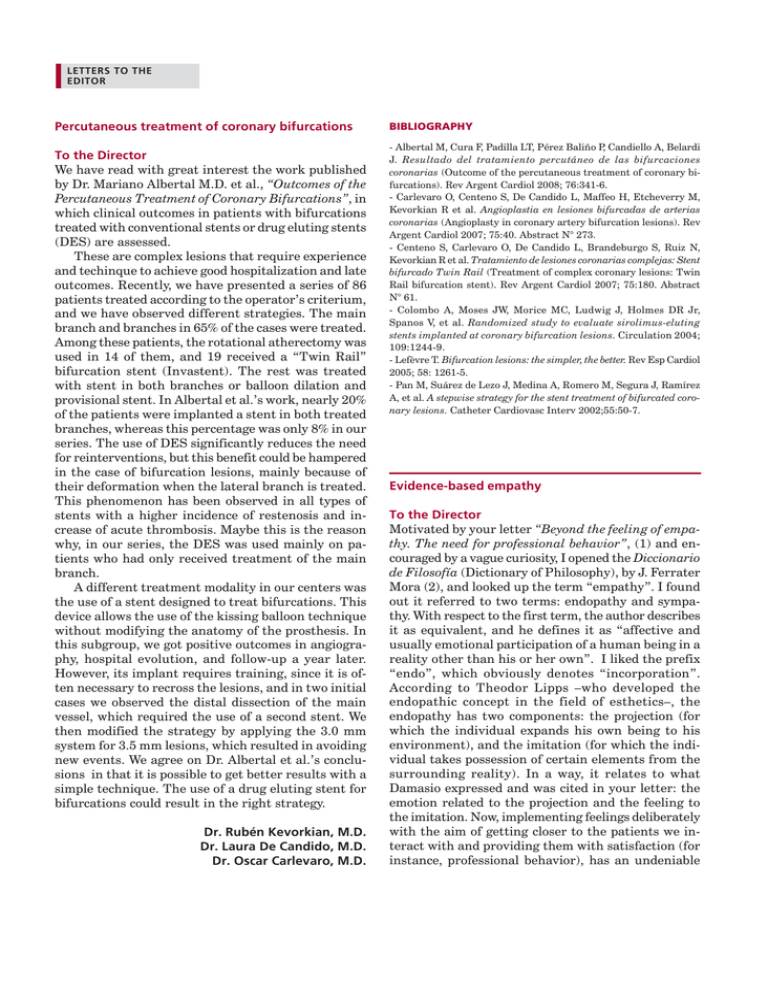
498 LETTERS TO THE REVISTA ARGENTINA DE CARDIOLOGÍA / VOL 76 Nº 6 / NOVEMBER-DECEMBER 2008 EDITOR Percutaneous treatment of coronary bifurcations To the Director We have read with great interest the work published by Dr. Mariano Albertal M.D. et al., “Outcomes of the Percutaneous Treatment of Coronary Bifurcations”, in which clinical outcomes in patients with bifurcations treated with conventional stents or drug eluting stents (DES) are assessed. These are complex lesions that require experience and techinque to achieve good hospitalization and late outcomes. Recently, we have presented a series of 86 patients treated according to the operator’s criterium, and we have observed different strategies. The main branch and branches in 65% of the cases were treated. Among these patients, the rotational atherectomy was used in 14 of them, and 19 received a “Twin Rail” bifurcation stent (Invastent). The rest was treated with stent in both branches or balloon dilation and provisional stent. In Albertal et al.’s work, nearly 20% of the patients were implanted a stent in both treated branches, whereas this percentage was only 8% in our series. The use of DES significantly reduces the need for reinterventions, but this benefit could be hampered in the case of bifurcation lesions, mainly because of their deformation when the lateral branch is treated. This phenomenon has been observed in all types of stents with a higher incidence of restenosis and increase of acute thrombosis. Maybe this is the reason why, in our series, the DES was used mainly on patients who had only received treatment of the main branch. A different treatment modality in our centers was the use of a stent designed to treat bifurcations. This device allows the use of the kissing balloon technique without modifying the anatomy of the prosthesis. In this subgroup, we got positive outcomes in angiography, hospital evolution, and follow-up a year later. However, its implant requires training, since it is often necessary to recross the lesions, and in two initial cases we observed the distal dissection of the main vessel, which required the use of a second stent. We then modified the strategy by applying the 3.0 mm system for 3.5 mm lesions, which resulted in avoiding new events. We agree on Dr. Albertal et al.’s conclusions in that it is possible to get better results with a simple technique. The use of a drug eluting stent for bifurcations could result in the right strategy. Dr. Rubén Kevorkian, M.D. Dr. Laura De Candido, M.D. Dr. Oscar Carlevaro, M.D. BIBLIOGRAPHY - Albertal M, Cura F, Padilla LT, Pérez Baliño P, Candiello A, Belardi J. Resultado del tratamiento percutáneo de las bifurcaciones coronarias (Outcome of the percutaneous treatment of coronary bifurcations). Rev Argent Cardiol 2008; 76:341-6. - Carlevaro O, Centeno S, De Candido L, Maffeo H, Etcheverry M, Kevorkian R et al. Angioplastia en lesiones bifurcadas de arterias coronarias (Angioplasty in coronary artery bifurcation lesions). Rev Argent Cardiol 2007; 75:40. Abstract N° 273. - Centeno S, Carlevaro O, De Candido L, Brandeburgo S, Ruiz N, Kevorkian R et al. Tratamiento de lesiones coronarias complejas: Stent bifurcado Twin Rail (Treatment of complex coronary lesions: Twin Rail bifurcation stent). Rev Argent Cardiol 2007; 75:180. Abstract N° 61. - Colombo A, Moses JW, Morice MC, Ludwig J, Holmes DR Jr, Spanos V, et al. Randomized study to evaluate sirolimus-eluting stents implanted at coronary bifurcation lesions. Circulation 2004; 109:1244-9. - Lefèvre T. Bifurcation lesions: the simpler, the better. Rev Esp Cardiol 2005; 58: 1261-5. - Pan M, Suárez de Lezo J, Medina A, Romero M, Segura J, Ramírez A, et al. A stepwise strategy for the stent treatment of bifurcated coronary lesions. Catheter Cardiovasc Interv 2002;55:50-7. Evidence-based empathy To the Director Motivated by your letter “Beyond the feeling of empathy. The need for professional behavior”, (1) and encouraged by a vague curiosity, I opened the Diccionario de Filosofía (Dictionary of Philosophy), by J. Ferrater Mora (2), and looked up the term “empathy”. I found out it referred to two terms: endopathy and sympathy. With respect to the first term, the author describes it as equivalent, and he defines it as “affective and usually emotional participation of a human being in a reality other than his or her own”. I liked the prefix “endo”, which obviously denotes “incorporation”. According to Theodor Lipps –who developed the endopathic concept in the field of esthetics–, the endopathy has two components: the projection (for which the individual expands his own being to his environment), and the imitation (for which the individual takes possession of certain elements from the surrounding reality). In a way, it relates to what Damasio expressed and was cited in your letter: the emotion related to the projection and the feeling to the imitation. Now, implementing feelings deliberately with the aim of getting closer to the patients we interact with and providing them with satisfaction (for instance, professional behavior), has an undeniable 499 LETTERS TO THE EDITOR Hippocratic root. One of Hippocrates’ writings, On the Physician, provides guidelines regarding how to speak and behave, trying to look serious and friendly, concerned but with no bitterness, avoiding being rude; it expressly recommends the physician that he be “fair in any treatment, since justice will be of great help to him. The relationship between the physician and his patients is not a minor issue. Since they (the patients) are in the hands of physicians… they have to control themselves, first and foremost”. (3) In spite of these illustrious antecedents, many of us have the feeling that the professional conduct is getting lost. How can these concepts be used to build an adequate professional behavior? If evidence is to be found in PubMed, there are 10,396 quotations for the term “empathy” and 2,973 for “empathy AND education”. The fact that one third of the registered articles refer to education illustrates the magnitude of the problem. An interesting example is a systematic revision of qualitative studies that assessed educational interventions on empathy on medicine students, which reveals that it is possible to get improvements in this field. (4) While the way to measure empathy is food for debate, the article suggests that education can be effective. How to implement this in the degree plan is another conflictive issue. We are aware that studying Bioethics and Deontology in a nineteenth century style has not achieved great results in the current groups of students. The teachers will have to take up the glove and adapt that content to the new learning styles. Dr. Mariano Giorgi, M.D. BIBLIOGRAPHY 1. Doval HC. Beyond the feeling of empathy. The need for professional behavior. Rev Argent Cardiol 2008; 76:330-4. 2. Ferrater Mora J. Endopatía. In: J. Ferrater Mora. Diccionario de Filosofía. 1st edition Barcelona: Ed Ariel Filosofía; 2004. Tomo II, p. 1008-12. 3. Hippocrates. Sobre el médico (On the Physician). In: Juramento hipocrático (Hippocratic Oath) Tratados Médicos. Buenos Aires: Ed Planeta-DeAgostini; 1995. p. 73-80. 4. Stepien KA, Baerstein A. Educating for empathy. J Gen Intern Med 2006; 21:524-30.
